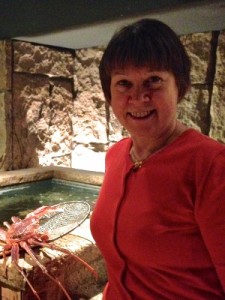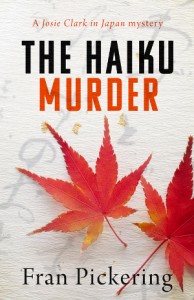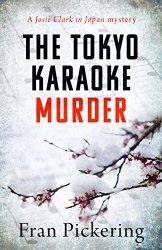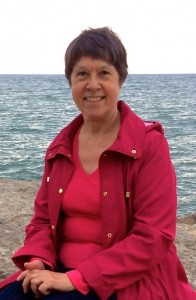Fran Pickering is a London-based murder mystery writer. She was born at the foot of Alexandra Palace (or Ally Pally as the locals call it), famous as the place from which the BBC made the world’s first television broadcast in 1936, but she grew up in South London and went to school in Catford.
When her family emigrated to Canada she stayed behind, working as a trade union negotiator, a web content developer and a communications specialist. She has lived and worked in Tokyo, where the Josie Clark in Japan mysteries are set, and has travelled all over Japan. She speaks and writes fluent Japanese and is married to a philosopher.
She now lives at the foot of Alexandra Palace once again, and dances the tango, tap and ballet in any time she can spare from writing.
Q: Where is The Cherry Blossom Murder set and how did you decide on its setting?
A: It’s set in Japan, partly in Tokyo and partly in a small town in the mountains outside Osaka called Takarazuka, home of the unique and spectacular all-female Takarazuka Revue. The Takarazuka Revue is one of the biggest theatre companies in Japan and yet it’s hardly known in the West, which is why I wanted to write about it. It’s a fascinating world. The Takarazuka star actresses have large and enthusiastic fan clubs with their own arcane rules, and my story is set inside one of them. It begins when expat Londoner and fan club member Josie Clark finds the body of a fan club helper under the cherry blossom on the Flower Path that runs past the stage door.
Takarazuka has a theatre in Tokyo too, so the story moves from the peace of the little town in the mountains to the excitement and bustle of Tokyo and back again. I know Tokyo well as I used to work there (and I still belong to a Takarazuka fan club).
I decided to set the story at Takarazuka to give readers a glimpse behind the scenes of a remarkable Japanese phenomenon. The theatre and its actresses are glamorous but the lives of the fans are quite ordinary so it offered a lot of scope. Readers often say they enjoy the way the book immerses them in Japanese culture — especially the different cultural assumptions and, of course, the food!

Q: At what point in writing the book did you come up with its title?
A: Very early on — before I started writing. I wanted a title that immediately said to people that this was a book about Japan, and cherry blossom is one of the key symbols of Japan. I also liked the contrast between the beauty of cherry blossom and the awful reality of murder.
It was a fun challenge to write a book to fit the title. I did the same with my second book, The Haiku Murder.
Q: You generally write in the genre of crime and mystery. What can readers expect?
I write in the tradition of Agatha Christie and the golden age of detective fiction. So I play fair with readers — I give them all the information so they have as much chance of working out who the murderer is as Josie does. I try to set up a puzzle, like solving a crossword. I don’t do gore or violence. My books are close to being cosy mysteries, except that instead of being set in a country village they’re set in one of the most exciting cities in the world.
There’s also a strand of romance as Josie tries to reconcile her desire to live and work in Japan with her relationship with English boyfriend Dave. Their attempts to find a way to make their relationship work gather pace through the series (the second book, The Haiku Murder, has just come out).
Q: Do you have a method for creating your characters’ names and what do you think makes a name believable?
A: Names are a big issue for me! I want the names of Japanese characters to be authentic, but most Japanese names have six syllables, three in the given name and three in the family name. Western readers find that hard to cope with, so I try to use names that are shorter than average and to give characters nicknames that are accessible to Western ears. So the actress whose fan club Josie belongs to is called Tammy, and Josie’s Japanese boyfriend is called Ken. It’s actually short for Kenichiro, so Ken is a useful crossover name.
I also modify the usual Japanese convention of using family names even with people you know well. So Josie calls her best friend by her given name, Keiko, and the owner of Chez Liline (another westernised name) is referred to as Liline, not as Ms Komatsubara. For men who are senior to Josie at work I have stuck with the Japanese convention, so her friend and mentor is called Mr Tanaka.
Josie comes from south London, and so does her English boyfriend, Dave. I wanted them to have very down-to earth names, so they’re called Josie Clark and Dave Taylor. I was pleased when I found a names map of London that showed both Clark and Taylor are common south London names. It showed I’d got the feeling right.

Q: Is your writing plot-driven or character-driven?
A: Even though it’s a twists-and-turns whodunnit, it’s character driven. I didn’t even make up my mind who the murderer would be until I was halfway through the book and the characters had begun to come to life. Once they did that, they took over and all I had to do was hang on for the ride.
One of the nice things about writing a series is that the characters have room to grow and develop, and you can take on board reader comments on earlier books to move things in the direction people want. I nearly left Mr Tanaka out of the second book as he didn’t have a strong role to play, but then my friends all said he was their favourite character, so I wrote him back in and will give him a prominent role in the third book, The Bullet Train Murder.
Q: Have you ever found that a book you were reading was influencing your writing style?
A: Definitely. I learn a huge amount from other writers and I consciously use what I’ve learned. At the moment I’m re-reading Wilkie Collins’s The Moonstone. It’s fascinating how he creates suspense by having characters fail to get together at a point where, if they had, an important clue would have been shared.
For example, when Doctor Candy writes to Franklin Blake to say he has something to tell him, Franklin doesn’t think it matters and doesn’t bother to go and see him. When he eventually does go, illness has affected the doctor’s memory, so he can’t pass on the piece of information which Franklin has now realised is vitally important. The reader shares Franklin’s frustration and bafflement — job done!
Q: When you are writing, do you work to a set word-count?
A: When I’m writing the first draft I aim to produce a thousand words a day, and to keep on moving forward at that rate until I have around 70,000 words. I don’t look back or rewrite during the first draft — all that comes later. Once I have a basic manuscript that I can rewrite, I work more to set timescales than set word counts.
I do think it’s important to commit to writing a certain amount each day, but you also have to allow time to pause and rethink if the story has taken a wrong turning. That’s why I wouldn’t want to do NaNoWriMo — I think the risk of carrying on writing when you’re going in the wrong direction is too great.
Q: What were the key factors that influenced your decision to become an indie author?
I love being in complete control — of when my books are published, what their covers look like and how they’re marketed. I’ve learned a whole set of new skills, like design and formatting, and I’ve built a social media platform which is fun in itself as well as being good for marketing. I know it sounds counter-intuitive, but I’ve met so many new people through being an indie author. Trouble is, my social life has expanded so much it’s hard to find time to write!
Q: In an interview about self-publishing, asked about advice he has for fellow authors, Hugh Howey recommends patience and says that you can’t lose if you combine happiness with low expectations. How do react to that? Is there any advice you would add?
I think that’s brilliant advice. When you tell people you’ve written a book, they immediately start speculating about its being a best-seller and the film rights being snapped up, but it’s not like that at all. It takes time and if you let the process discourage you, you’ll never succeed. I’d add a piece of advice I read recently on a blog: ‘Build your readership one reader at a time.’
Q: Who designed your book cover/s and what brief did you give them?
My book covers are designed by Andrew Brown of Design for Writers. For The Cherry Blossom Murder I tried to leave him free to come up with an idea (he’s the designer not me) so I just said that I wanted to use cherry blossom on the cover in some way. When I first saw the design I was surprised — it was nothing like I’d imagined it would be. But he’s done a great job of making cherry blossom look sinister rather than sweet and positioning the book firmly in the crime genre.
It got more interesting with the second book, particularly as I published a prequel novelette at the same time. There was a real back-and-forth process where we worked together on understanding what my author identity should be and how to express it through the covers. We settled on the seasonal flowers and plants theme which I really love, but struggled to come up with an image for the novelette, The Tokyo Karaoke Murder. In the end I said ‘if you design a cover with snow on it, I’ll write some snow into the story’ and that’s what we did. And, do you know, the story was much better with snow in it.

Q: When I was growing up were The Owl Service by Alan Garner, Anne of Green Gables by L M Montgomery and The Magic Pudding by Norman Lindsay. What were yours?
Black Beauty by Anna Sewell, The Little White Horse by Elizabeth Goudge (hmm, bit of a horse theme there) and The Secret Garden by Frances Hodgson Burnett. I think the opening chapter of The Little White Horse, in which Maria and Miss Heliotrope and Wiggins travel to Moonacre and discover the little room in the turret that is to be Maria’s own, is the most enchanting piece of descriptive writing I’ve ever come across. The Secret Garden really makes you understand and love Mary and Colin. I like it that Mary starts out as a sallow, self centred child whom nobody likes, and Colin is a complete pain. It makes the transformation they go through so much more absorbing.
You can find out more about Fran and her work by
* visiting her website which has details and sample chapters of her books, plus posts of classic haiku and photos of cherry blossom. http://franpickering.com
* visiting her blog where she writes about Japanese art and events in London
* following her on Twitter (@franpickering)
* dropping by her author page on Amazon, which has links to all her books.



